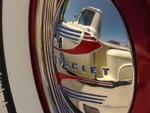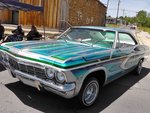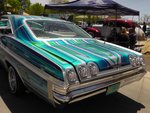



Two defining characteristics of Hispanic culture include devotion to and love for family and friends, and a strong work-ethic. When a lightning storm recently destroyed Daniel Fierro's home in Hurley, members of "Viejitos" Car Clubs, friends from all over the Southwest, rallied in Santa Clara, New Mexico for a "Show and Shine" to help their friend rebuild the home he shared with his partner, Lilly Aguilera.
The promenade of old cars lined the main street of the sleepy little village of Santa Clara. There was music, food, drink, much laughter and a contagious enthusiasm when club members spoke about their applied art form: moving metal sculpture, also known as old cars or "Viejitos."
Tony Ramirez, who taught auto mechanics at Cobre Schools, explained that sometimes outsiders think of all "Viejitos clubs" as low-riders' clubs, but they are really two separate art forms.
"Some of us just love to restore old cars to their original look, and some of us love to add hydraulics to ‘lift’ the old cars so that they dance,” Ramirez said. “It's a personal preference. But we are all part of the same club. We all support and encourage each other because working on old cars is a family tradition and keeps memories alive."
Ramirez and his significant other, Linda Nunez, had a 1940 Chevy Special Deluxe that he said took over two and a half years to bring back to mint condition.
"You never reclaim your money or your time, so you have to love what you are doing ... and I do,” he said. “I bought this car many years ago and waited until I retired to begin work on it."
He is currently working on 15 different vehicles!
The next old car that caught my eye belonged to Casey Holguin. She and her significant other, Jason Benavides, have lovingly restored a 65 Chevy Impala. They named it "Drifting on a Memory." Every part of the car is color coordinated.
"There is a pound of flake in that paint job," Benavides said.
Holguin told me how she and Benavides worked for months taping and painting the exterior, making sure everything reflected their vision of what it feels like to drift on a memory. I would love to take a cruise in this Viejito and enjoy the grins that appear on everyone’s' faces as we float by ... maybe it will happen.
Next a 1964 Chevy Impala owned by Fernando Chavez of Lordsburg caught my eye. A low-slung brown beauty, it IS a low-rider and sports both a chrome-plated engine and a chrome-plated trunk full of hydraulics to prove it.
"This was our family car, Mom's grocery-getter,” Chavez said. “I love low-riders, do all the hydraulics myself. Two separate motors; eight solenoids control the lift – it goes up and down, side to side and back to front. Every time I drive it, I think loving thoughts about my mom. It is a labor of love and it gives the young kids something to look up to."
Chavez said there aren't too many old car/low-rider enthusiasts in Lordsburg but he hopes that will change.
"There are more Viejitos in Grant County, Cruces, El Paso, Deming and Arizona. But I got the word and came right up to help out Daniel because that is what we do," he said.
Chuey Silva, formerly of Las Cruces, proudly displayed a 1965 Impala.
"I found her and had to have her" he said. "It's about getting together, working together, making friends. I've always loved old cars. We all get together – it's like a family."
Silva's old car has new seats, carpeting, the original sound system and an immaculate paint job. He puts it on a trailer to take to car shows.
"We have a lot of fun cruising around, meeting new people, talking about cars," he said. "They ARE works of art. You don't want some distracted driver crashing into you!"
Fred Balderrama brought his Custom 1948 Chevy Truck over for the "how and Shine. Balderrama is president of the El Paso Viejitos Car Club. He is a dignified, white-haired gentleman who speaks with quiet authority.
"This show is to help a member who suffered a tragedy, but we also come out for weddings, ceremonies and anniversaries,” he said. “We are here to help and support each other through whatever life gives us – the good and the bad. Actually it's ALL about history – to make them look new again. To take something old and almost dead and bring it back to life. It's our passion to keep history alive."
He went on to tell me that the original Viejitos Car Club was established in California in 1985, but now has expanded all over the United States, even world-wide, with clubs in Europe and Japan.
"We are all about family,” Balderrama said. “We help each other, we get together with projects and work together on builds. As our children get older they get involved, they love it. We show up for parades, weddings, anniversaries, coming-of-age celebrations, birthdays. We are here to help."
When I asked Mr. Balderrama why they call the cars "Bombs' he explained that it describes their shape.
"Many old cars from the era of 1949-1959 were shaped like bombs,” he said. “But as long as it is an old, American-made car, we love it. Chevys, Plymouths, Chryslers, Fords, they are all good. The original club included only cars made in the USA between 1949 and 1959, but we accept cars that are younger than that, as long as they are made in America."
Baldarrama said they find cars at “swap meets and back yards, not junk-yards.”
"Not just anybody can join our club ,” he said. "We take pride in what we do and expect our members to conduct themselves with dignity, respect, loyalty and responsibility."
I am honored to have had this opportunity to learn more about an art form of which I had little direct knowledge. The effort and creativity demonstrated by a "Show and Shine" elevates them into a category of contemporary performance art called "Happenings." They show up, strut their stuff, enjoy a procession or a parade, help a friend and then dematerialize back into the safety of somebody's garage – until the next time.
As Daniel Fierro said of a club member's viejito that lost a wheel as it returned to Arizona: “It gives new meaning to the term 'He gave until the wheels fell off.’”
Since 1988 Paula Geisler has owned and operated Geisler Gallery in downtown Silver City. She is a radio talk-show Host on KURU, 89.1 FM, produces video documentaries, and practices feng-shui. In her spare time, she raises tropical fish and conducts tours of her “Significant Historic House,” now repurposed as an arts incubator.